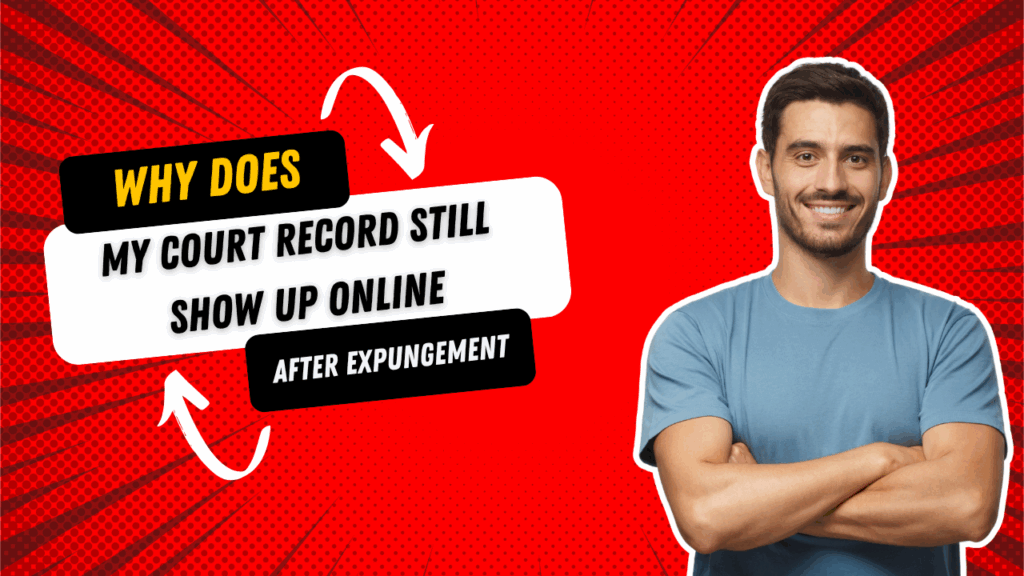You went through the process. Filed the paperwork. Got your court record expunged. So why is it still showing up online?
Short answer: the internet moves faster than the courts. And most websites don’t clean up on their own.
Here’s what’s going on, and what you can do about it.
Dig Deeper: How to Remove Court Records from Google Search
What Expungement Actually Does
Sealing vs. Deleting
Expungement seals your record at the court level. That means it’s no longer available through government websites or physical searches. But it doesn’t delete everything automatically.
Old copies of your case might still live on:
- News articles
- Mugshot databases
- Background check websites
- Archived court listings
Google isn’t tied to the court system. It only knows what’s still out there.
“I had my DUI expunged but it still showed up on a background site. Turns out they copied it years ago and never updated it,” said one client.
This is common.
Expungement clears the source. But it doesn’t clean up the mess others made with your record.
Why It’s Still Online
Cached Content and Copies
Sites often copy court records when they’re first published. Even if the court deletes the file later, third-party sites may not get the update.
Some sites automate this. Others do it manually, then never revisit.
Google Cache
Sometimes the court record is already gone, but Google’s memory holds onto it. You might be seeing a cached version. This can stay in place for weeks or months unless you request a takedown.
Background Check Companies
Sites like MyLife, Spokeo, and BeenVerified gather and resell public info. They pull data fast but don’t always remove it when that info changes.
Even if your record is sealed, it might be stuck in one of their reports unless you opt out.
News Sites
News articles are rarely updated. If your arrest made the news, it could stay online forever—even if the case was dropped and expunged.
Some sites will update or remove stories if you ask. Others won’t.
How to Remove It From the Internet
Step 1: Search Yourself
Google your name in quotes. Try it with and without your middle name. Check for:
- Court record PDFs
- Mugshot listings
- News stories
- Background check profiles
Make a list of every site that still shows your expunged case.
Step 2: Contact the Sites Directly
Send removal requests to each website. Include proof of expungement. Be polite and specific.
Sites like FastPeopleSearch and Whitepages have opt-out pages. For others, use their contact forms or legal request emails.
One user said, “I emailed five background sites with my expungement order. Three removed it in under a week. The others needed a follow-up.”
Persistence pays off.
Step 3: Remove Outdated Content from Google
Use Google’s Outdated Content Tool to remove leftover pages or summaries.
Paste the link. Select the reason. Submit.
It usually takes a few days. This works best for:
- Cached pages
- Broken links
- Outdated descriptions
Step 4: Opt Out of Background Sites
Most background check companies allow you to opt out. But it’s a grind. Each site has its own rules. Some require ID. Some ask for verification codes.
Start with these:
- BeenVerified
- Spokeo
- Intelius
- PeopleFinders
- TruthFinder
Be patient. Some take 1–2 weeks to complete removals.
What If the Site Refuses?
Try a Legal Approach
If a site won’t remove expunged content, you can send a cease and desist letter. You may also file a complaint with the FTC or state attorney general.
Sometimes just mentioning legal rights gets their attention.
You don’t always need a lawyer, but having one can speed things up.
Suppress With SEO
If removal fails, suppression is your backup plan.
This means flooding Google with new, positive content so the bad results fall off page one.
Create:
- A personal website
- Active social profiles
- Blog posts, articles, or videos under your name
Most people never scroll past page one of search results. If you can push your record to page two, it’s basically gone.
One client buried a two-year-old arrest record by launching a personal blog, updating her LinkedIn, and publishing an op-ed in her local paper.
This strategy takes time but works long term.
How Long Will It Take?
| Method | Timeframe |
|---|---|
| Site Removal Requests | 1–3 weeks |
| Google Cache Cleanup | 3–7 days |
| Background Site Opt-Out | 1–4 weeks |
| SEO Suppression | 1–3 months |
It’s not instant. But every step helps lower the visibility of your old record.
You’re Not Alone
Nearly 1 in 3 Americans has a criminal record. Many qualify for expungement, but few know how to follow through after.
That’s why reputation cleanup matters. The court may be done with your case. The internet isn’t.
If you’re overwhelmed, a reputation management service like Top Shelf Reputation can help clean up search results, monitor for new content, and build positive visibility.
Final Tip
Expungement is just step one. You still have to scrub the web.
Stay organized. Stay persistent. And start with the biggest search engines first. The faster you act, the less damage your old record can do.

